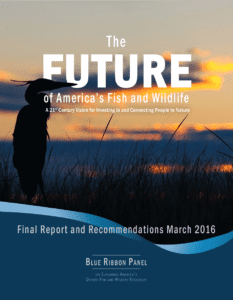Recovering America’s Wildlife Act idea has been around at least six years
mark the 21st Century’s contribution to the country’s history of major wildlife conservation initiatives. Wildlife funds over the decades Congress passed the Pittman-Robertson Act in 1937 to create a conservation fund financed by hunters and recreational shooters. Carrying the model forward for sports fishing, the Dingell-Johnson Act of 1950, also called the Federal Aid in Sportfish Recreation Act, paved the way for fisheries management. Science-based fisheries and wildlife management carried out by the states brought back depleted white-tailed deer populations, wood ducks, striped bass, and many other fish and game species. These developments served to create the backbone of a healthy outdoor lifestyle for millions of Americans. It fueled a multi-billion dollar outdoor recreation industry. But decades later conservation leaders still recognized a looming wildlife conservation crisis. More species required help, among them the prairie chicken, Arctic grayling, songbirds, myriad insects, and fishes. Numerous funding vehicles attempted through the 1980s and 1990s fell short. Despite some great success stories, more species continued on a trajectory toward federal listings as threatened or endangered under the federal Endangered Species Act. Those ESA listings came at high regulatory and fiscal costs for government, industry and private landowners. In 2000 and 2001, Congress created the State Wildlife Grant Program and the Tribal Wildlife Grant Program as proactive wildlife management measures. Each state was directed to create its own Wildlife Action Plan to guide expenditures. Disbursements to tribes were elevated in 2008 with competitive grants awarded to projects requiring matching funds. The resulting programs created a new era of cooperation between the U.S. Fish and Wildlife Service with state, commonwealth, territory, and tribal entities, according to an Interior Department’s 20th-anniversary grant program report issued in September 2020.
Wildlife crises continued Still, wildlife conservation puzzles persisted. In 2015 Bass Pro Shops founder Johnny Morris and former Wyoming Governor David Freudenthal co-chaired and convened The Blue Ribbon Panel On Sustaining America’s Diverse Fish and Wildlife Resources. It included a diverse group of 26 national conservation and industry leaders. The group stated that it believed the nation did indeed face a wildlife conservation crisis. It determined the state grants program was falling far short of what the states needed. The grant programs have been the main funding source for nongame wildlife conservation for the past 21 years. Even so, the program hit a high of $90 million in 2010 but the average annual appropriation has been closer to $60 million. So, over the course of 21 years the program issued a cumulative total only slightly above the panel’s suggested $1.3 billion yearly allocation. In its final report, the panel states: “We need to act now to build a safety net for all fish and wildlife, create regulatory certainty for business and address the growing disconnect between people and nature. Failure to do so will mean that our generation will leave the nation’s rich natural assents impaired, rather than increased in worth.” The panelists noted that they believed the 21st Century needed a stronger proactive management strategy. It saw an opportunity to pull $1.3 billion from existing oil and gas drilling fees. The idea is similar to what is before Congress today. The Recovering America’s Wildlife Act would pull funding from environmental fines and penalties paid by industry. In its closing paragraph, the report states: “Our generation will be judged by the state in which we leave these resources to the next. We must pick one of two paths. Do we proactively invest in conservation to ensure fish and wildlife are sustained or saddle the next generation with the high cost of recovering the species whose care we neglected? We believe that the right path is to begin investing NOW in a 21st-century vision for fish and wildlife.” Kelly Bostian is an independent journalist writing for The Conservation Coalition of Oklahoma Foundation, a 501c3 non-profit dedicated to education and outreach on conservation issues facing Oklahomans. To learn more about what we do and to support Kelly’s work, see the About the CCOF page.
0 Comments
Leave a Reply. |
Archives
May 2024
Categories
All
|
Conservation Coalition of Oklahoma
P.O. Box 2751
Oklahoma City, OK 73101
[email protected]



